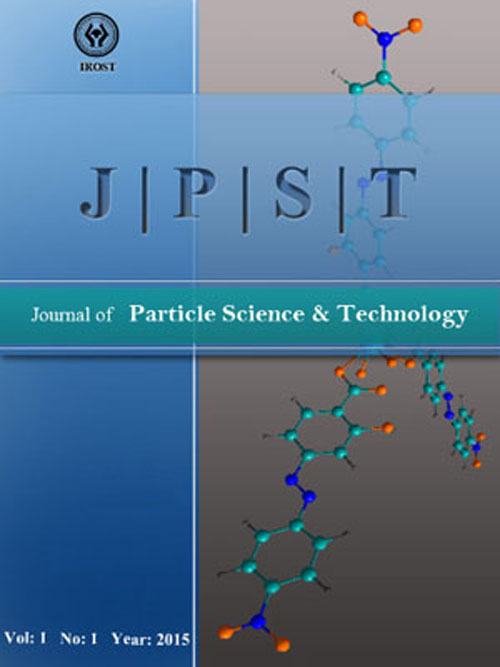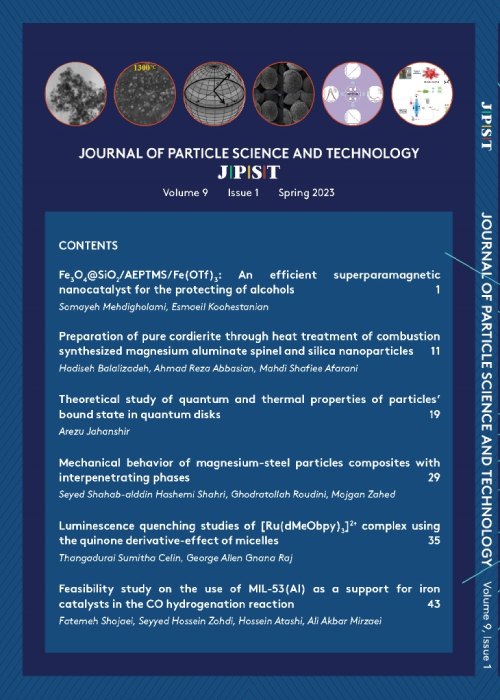فهرست مطالب

Journal of Particle Science and Technology
Volume:3 Issue: 4, Autumn 2017
- تاریخ انتشار: 1397/01/25
- تعداد عناوین: 6
-
-
Pages 175-186With the advancement of metagenome data mining science has become focused on microarrays. Microarrays are datasets with a large number of genes that are usually irrelevant to the output class; hence, the process of gene selection or feature selection is essential. So, it follows that you can remove redundant genes and increase the speed and accuracy of classification. After applying the gene selection, the dataset is reduced and detection of differentially abundant genes facilitated with more accuracy. This will, in turn, increases the power of genes which are correctly detected statistically differentially abundant in two or more phenotypes. The method presented in this study is a two-stage method for functional analysis of metagenomes. The first stage uses a combination of the filter and wrapper gene selection method, which includes the ant colony algorithm and utilizes fuzzy rough sets to calculate the information gain ratio as an evaluation measure in the ant colony algorithm. The set of features from the first stage is used as input in the second stage, and then the negative binomial distribution is used to detect genes which are statistically differentially abundant in two or more phenotypes. Applying the proposed method on a microarray dataset it becomes clear that the proposed method increases the accuracy of the classifier and selects a subset of genes that have a minimum length and maximum accuracy.Keywords: microarray, gene selection, phenotype, fuzzy rough set, ant colony optimization, Gain ratio
-
Pages 187-195Recently, the synthesis of silver nanoparticles has become an important subject in the bionanotechnology field. Many different chemical and physical methods could be used for silver nanoparticles synthesis, but they are limited due to the usage of toxic chemicals and the production of dangerous by-products. However, the usage of plant extract for silver nanoparticles synthesis is a green single-step method without using toxic chemicals. Herein, silver nanoparticles were synthesized using Lithospermum officinale root aqueous extract and their antioxidant activity was evaluated in vitro. The results showed that 1 ml of the extract could reduce 9 ml of silver ions (1 mM) to silver nanoparticles by heating the reaction mixture (60 ºC) for 6 hours at pH 7.0. The synthesized silver nanoparticles were detected by UVVis spectroscopy, TEM, FT-IR, DLS, and XRD. The synthesized silver nanoparticles spectrum had a maximum peak at 390nm, and TEM analysis indicated spherical particles, higher stability (zeta potential: -15.3 mV) and an average size of 7 nm. The antioxidant activity of the synthesized silver nanoparticles was 0.07 mg/ml compared to L. officinale root aqueous extract (0.142 mg/ml) which indicated higher antioxidant activity. So, it is concluded that the synthesized silver nanoparticles could be considered a clinical therapeutic potential due to its antioxidant property.Keywords: Lithospermum officinale, Root aqueous extract, Silver nanoparticles, Green method, Antioxidant
-
Pages 197-209The main aim of this study was to prepare apple pomace polyphenolic extract (APPE- referred to as a core) loaded into biodegradable and commercially available natural polymer such as maltodextrin (MD-referred to as a shell). The polymer coating potentially improves its low stability and bioavailability and also directs the control release of the encapsulated material. The MD-nanoparticles (NPs) loaded with the APPE were prepared by a modified nanoprecipitation method. An experimental central composite design was utilized for the modeling, optimization and to assess the influence (and interactions) of the shell to core ratio, surfactant concentration, and sonication time (as the independent variables) on the NPs preparation to maximize the level of polyphenols loading and the NPs formation yield (referred to as dependant variables). The adopted models were verified statistically and experimentally. The results showed that amongst the independent variables, the shell to core ratio and the surfactant concentration were statistically significant in the experimentally selected ranges. By adopting the optimal process conditions, the spherical shaped NPs were prepared with a mean average size of 52 nm (confirmed by the Dynamic Light Scattering and FE-SEM techniques) and polyphenols loading efficiency of 98%. FT-IR spectroscopy confirmed the successful entrapment of the core in the shell of NPs. Hydrogen bonding is one of the modes of interactions between the hydrophilic moieties of polyphenols and MD. The in vitro polyphenols release of the NPs through simulating cancerous tumor acidity conditions represented a sustainable release, indicating potential anticancer application of the NPs.Keywords: Process optimization, Natural polymers, Nanoencapsulation, Apple pomace polyphenolic extract, Nanoprecipitation
-
Pages 211-218A novel Nafion®-based nanocomposite membrane was synthesized to be applied as direct methanol fuel cells (DMFCs). Carbon nanotubes (CNTs) were coated with a layer of silica and then reacted by chlorosulfonic acid to produce sulfonate-functionalized silicon dioxide coated carbon nanotubes (CNT@SiO2-SO3H). The functionalized CNTs were then introduced to Nafion®, and subsequently, methanol permeability, proton conductivity, ion exchange capacity (IEC) and water uptake properties of the prepared membranes were investigated. The experimental results showed that the water uptake and IEC of the Nafion®/CNT@SiO2-SO3H (1 wt%) membrane increased in comparison with the recast Nafion®. IEC was enhanced from 0.9 meq/g for the recast Nafion® to 0.946 meq/g for Nafion® /CNT@SiO2-SO3H, which could be attributed to the presence of sulfonate groups on the surface of CNTs. In addition, the proton conductivity of the sulfonate modified CNT/Nafion® composite was enhanced in a wide range of temperatures. Selectivity of the fabricated membrane was found to be more than 8-fold higher than that of recast Nafion® 117, demonstrating the promising potential of the produced membranes for DMFC applications.Keywords: Fuel Cells, Nafion, Sulfonate Modified CNTs, Proton conductivity, Membrane permeability
-
Pages 219-232Aluminum coating was prepared on AZ91D magnesium alloy substrate using the electrophoretic deposition (EPD) method in absolute ethanol solvent. In order to determine the optimal concentration of AlCl3.6H2O additive, the zeta potential and size of particles in the suspension were measured in the presence of different concentrations of AlCl3.6H2O. The results showed that an appropriate coating is obtainable in the presence of 0.6 mM AlCl3.6H2O as an additive. The effects of applied voltage, deposition time, and additive concentration on deposition weight, deposition thickness, and coating morphology were also studied. A uniform coating with smaller pores and higher density was obtained at the additive concentration of 0.6 mM, deposition time of 18 min, and applied voltage of 70 V. The thickness of this coating was measured at about 256.91 µm. According to the results of corrosion behavior studies, the corrosion current density was measured at 29.16 and 12.85 µA/cm2 for uncoated and aluminum-coated AZ91D alloy, respectively.Keywords: Aluminum coating, Electrophoretic deposition, AZ91D magnesium alloy, Coating morphology, Suspension stability
-
Pages 233-241An optimal artificial neural network (ANN) has been developed to predict the Nusselt number of non-Newtonian nanofluids. The resulting ANN is a multi-layer perceptron with two hidden layers consisting of six and nine neurons, respectively. The tangent sigmoid transfer function is the best for both hidden layers and the linear transfer function is the best transfer function for the output layer. The network was trained by a particle swarm optimization (PSO) algorithm. Nanofluid concentration, Reynolds number, and Prandtl number are input for the ANN and the nanofluid Nusselt number is its output. There exists an excellent agreement between the ANN predicted values and experimental data. The average and maximum differences between experimental data and those predicted by ANN are about 0.8 and 5.6 %, respectively. It was also found that ANN predicts the Nusselt number of nanofluids more accurately than the previously proposed correlation.Keywords: Nanofluids, Non, Newtonian, Artificial neural network, Multi, layer perceptron, Particle swarm Optimization


